
A TOOLKIT FOR STRATEGIC FOCUS
How to get your leadership to agree on strategic priorities
In this article, you’ll learn how to kick off your strategic planning process using the Strategy Kit—a tool designed to align your team quickly and effectively.
You’ll learn:
- How to define clear guiding principles to steer your team’s decisions.
- Why understanding internal and external forces is crucial to setting the right context.
- How to identify and prioritise strategic opportunities and risks for maximum impact.
- How to turn your strategic vision into an actionable one-page plan
Get your strategic plan started.
You’ve got a vision for the future, but getting your team aligned feels overwhelming. The Strategy Kit is designed for leaders like you—those balancing competing priorities, tight timelines, and the pressure to drive change.
Strategic planning is often seen as a drawn-out process filled with endless meetings, complex documents, and unclear outcomes—leaving teams confused about what’s most important and how to take action.
The Strategy Kit challenges conventional strategic planning, providing a streamlined, practical approach to align your team around a clear, actionable plan. This step-by-step guide cuts through the noise, giving you the structure to focus on what truly drives success. In just 3 hours, you’ll have a concise plan that’s easy to communicate and rally your team around, ensuring everyone is on the same page and ready to take action.
The Strategy Kit introduces 9 steps to streamline your strategic planning process:
- Guiding Principles: Set the foundation for decision-making and alignment.
- Context: Understand the internal and external forces driving change.
- Opportunities & Risks: Identify potential growth areas and challenges.
- Ambition: Define the impact on business, customers, and employees.
- Change Story: Communicate the rationale behind the strategy.
- Priorities: Align on the key areas to focus resources and efforts.
- Outcomes: Define success for each priority.
- KPIs: Measure progress with clear, actionable metrics.
- The Clarity Canvas: Summarize everything into a one-page strategic plan.
This guide can be used to facilitate your strategic planning session either in person or online. To see examples or facilitate with a remote team, we have designed a Miro companion workshop, available from the Sprint Valley Miroverse page.
STEP 1: GUIDING PRINCIPLES
Guiding Principles for Strategic Planning
Establishing clear guiding principles at the start of your strategic planning process helps align leadership on the core values and behaviours that will steer decision-making throughout the change journey. These principles provide consistency in how priorities are set, risks are managed, and opportunities are assessed, ensuring that your strategy stays true to your organisation’s culture and long-term vision.

How to set guiding principles
- Welcome: Begin with a brief welcome to bring everyone into the space. Explain that we’ll start by setting some guiding principles that will serve as the foundation for how we will work together to make strategic decisions.
- Note: Invite everyone to silently write down one behaviour they want the team to embrace and one they want to avoid during the planning process. Use post-its if in person or virtual sticky notes if online. Set a timer and after 2-3 minutes ask everyone to post their ideas on the wall.
- Vote & Heatmap: Give 60 seconds for participants to read the other responses. Each person places one red dot (or sticker of your choice) on the principle they find most critical to embrace, and one dot on what they feel is most important to avoid (this is called a ‘dot vote’). Use the results as a heatmap to facilitate a discussion on how these guiding principles will influence your collaboration throughout the planning process.
STEP 2: CONTEXT
Internal and external forces that set the context for strategic change
Before setting strategic priorities, it’s crucial to identify both internal and external forces pushing your organisation toward change. This step helps the team surface key drivers influencing the new strategic direction.
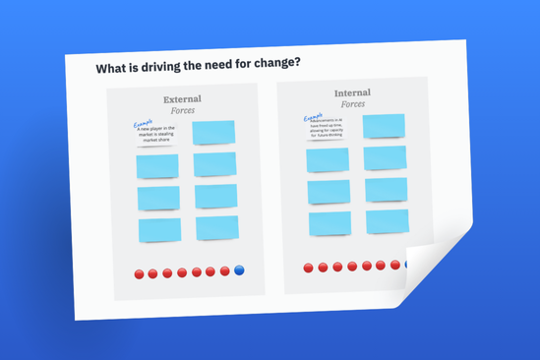
How to align on the forces impacting change
- Explain: Both internal (e.g., operational changes) and external (e.g., market competition) forces are driving the need for a new strategy. If any particularly impactful forces are already known, present them to the room for consideration.
- Note: Open the floor and ask the team to reflect on what they see driving the need for change. Silently write responses to each prompt (2-3 minutes).
- Vote: Take 60 seconds to review everyone’s contributions. Ask each person to use a red dot to indicate which external force and which internal force they believe is most significant.
- Discuss: Facilitate a discussion using the heatmap created by the dots to highlight the most critical factors. Use a timer to keep the session on track and avoid prolonged debate.
STEP 3: OPPORTUNITIES & RISKS
Opportunities and risks to consider in the strategic plan
Building on the context of internal and external forces, this step invites the team to explore the emerging opportunities and the risks that must be navigated with care. By recognising opportunities, the team can focus resources on areas with the highest potential for growth or market advantage. At the same time, acknowledging risks ensures the strategy accounts for potential roadblocks, making it more resilient and adaptable in a dynamic environment. This step helps balance ambition with practical awareness, aligning everyone around a realistic path forward.

How to identify opportunities and risks
- Explain: The forces driving the need for a new strategy may also reveal unexpected opportunities or hidden risks. Opportunities represent the emerging ‘white space’—such as new market trends, building on successes, or leveraging shifts in the competition. Risks are the challenges the business will need to navigate, which could be internal (e.g., resource limitations, staffing) or external (e.g., new competitors, regulatory changes).
- Note: Team members silently write down the key opportunities and risks.
- Vote: Take 60 seconds to read what others have written. Each person uses red dots to prioritize the top opportunities and risks.
- Discuss: Facilitate a discussion using the dot heatmap to focus on what matters most. Keep the process moving by using the timer to avoid excessive deliberation.
STEP 4: AMBITION
Ambitions for the business, customers and employees
This step captures the impact the new strategy will have on the business, employees, and customers. When everyone aligns around a shared ambition, it ensures that the strategy drives not only financial success but also broader, lasting improvements that motivate the team and generate satisfied, loyal customers.
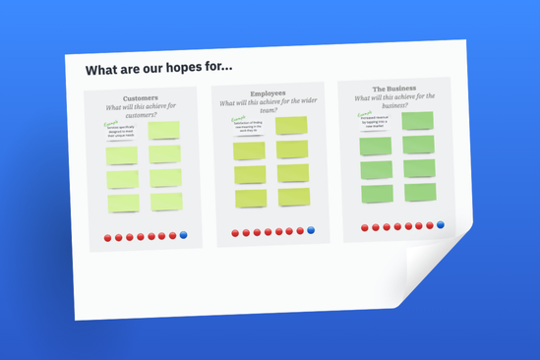
How to align ambitions
- Explain: Introduce the idea of ambition as the impact on Customers, Employees, and The Business. Emphasise that all 3 are important—it’s not just about business outcomes like revenue but also about raising standards of work, improving customer value, and increasing employee satisfaction.
- Note: Ask the team to silently write down their hopes for each area (Customers, Employees, and The Business).
- Vote: Let everyone silently read others' notes. Each person uses one red dot to vote for their top hope in each category. Briefly discuss the notes with the most votes and how these ambitions will guide the strategy.
STEP 5: CHANGE STORY
A change story the business can rally behind
Communicate the rationale behind your strategic shift and the benefits it brings. A well-crafted Change Story ensures that everyone understands and supports the vision, paving the way for successful implementation and commitment. Your change story will develop and evolve as you refine your strategy, this is just the beginning.
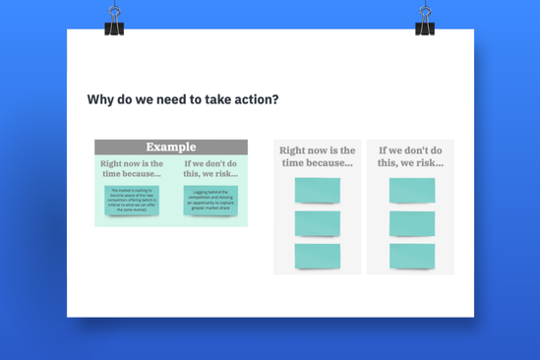
How to craft your change story
- Explain: The change story will set the frame for the importance of getting the strategic priorities right and create urgency around taking bold action. Emphasise that the work we do today is just the start of the story, we will continue to refine the change story as the strategy develops to connect with the team and inspire action.
- Note: Ask the team to silently write a statement that includes two parts:
- Right now is the time because…
- If we don’t do this, we risk… - Vote: After everyone is finished writing, silently read others' notes. Individually vote for the top statement. Briefly discuss the statements with the most votes and how this change story might shape the priorities we set.
STEP 6: PRIORITIES
Strategic priorities to make change happen
Align on what truly matters. Identifying and agreeing on strategic priorities ensures that your team focuses on the most critical areas that will drive success. This step helps streamline efforts by clearly defining where to allocate resources and attention, making sure that everyone is united in focusing on the areas that will have the greatest impact on achieving your vision.
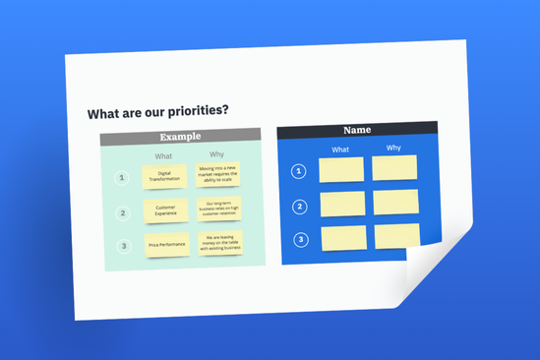
How to set strategic priorities
At this point in the process, your team likely has ideas about what the strategic priorities should be. It’s time to surface them in a constructive, collaborative way.
- Explain: It’s time to identify the specific areas of focus we believe are the right "levers to pull" to make change happen. Each of you will outline three priorities you believe will help us reach our ambitions. You’ll share what the priority area is (e.g. digital transformation) and why focusing here is essential to the success of the strategy.
- Note: Ask the team to silently write the three priorities they believe are most critical using the “what-why” formula.
- Share back: One-by-one ask the team to share their three priorities. 3 minutes should suffice. Use a timer to keep presentations focused and concise. If necessary, add another 2 minutes to the end of each presentation to allow the team to ask clarifying questions.
- Vote: After everyone has presented, post the list of priorities to the wall. Give each person 3 dots to vote for the priorities they believe are most critical (this may be their own or someone else’s). If necessary, nominate a decider to make the final decision to keep the process moving.
STEP 7: DESIRED OUTCOMES
Desired outcomes for priority areas
Clarifying the desired outcomes for each strategic priority helps articulate what success looks like and why it matters. This step ensures that every priority is not only actionable but also linked to meaningful results. By identifying these outcomes, you create a clear vision of how achieving each priority will drive your organization towards its overall strategic goals.
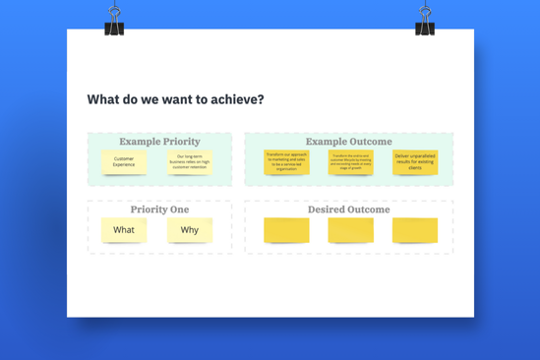
How to set desired outcomes
- Explain: Begin by discussing that desired outcomes are the specific impacts or benefits expected from addressing each priority area. These outcomes should reflect how they will advance your strategic vision.
- Note: Ask each person to silently write one outcome for each priority. Encourage them to think about what specific results would indicate that the priority has been successfully addressed.
- Vote: Silently review each other’s responses. Allow each person to vote for the outcomes (one outcome per priority) they believe are most critical. If necessary, designate a decider to finalise the outcomes, ensuring they are achievable and impactful.
STEP 8: KPIs
Key Performance Indicators (KPIs) for Measuring Success
Setting Key Performance Indicators (KPIs) ensures that you have a clear, objective way to measure and assess progress towards your strategic goals. KPIs provide critical insights into how well you are progressing in each priority area, enabling timely adjustments and ensuring alignment with your overall strategy.
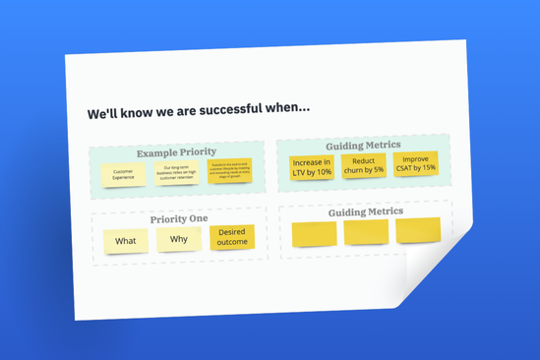
How to set KPIs
- Explain: Start by discussing that KPIs are specific, measurable metrics used to evaluate progress towards your strategic objectives. They should be aligned with each priority area and provide clear indicators of success.
- Note: Ask the team to silently write potential KPIs for each priority area. Encourage them to consider what metrics would effectively measure progress and success for each strategic objective.
- Vote: Allow each person to vote for the KPIs they believe are most valuable. You may choose 1-3 KPIs per pillar depending on your goals.
STEP 9: CLARITY CANVAS
Assemble your one-page strategic plan
Consolidate the insights and outputs from Steps 2 through 7 into a comprehensive one-page Strategic Plan. This canvas will serve as a visual summary of your change story, strategic priorities, objectives, desired outcomes, and key performance indicators, providing a clear and actionable roadmap for your team.
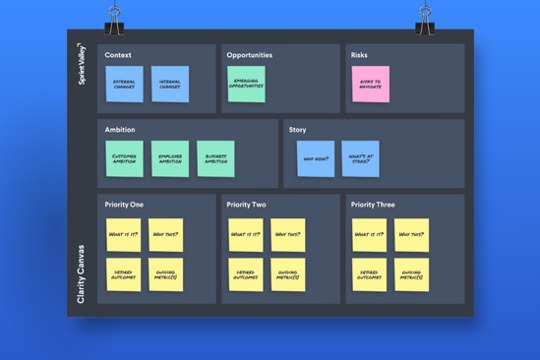
How to create your one-page strategic plan
- Compile & organise: Gather the results from each step—context, opportunities and risks, ambitions, change story, priorities, desired outcomes, and KPIs. Use these elements to populate the one-page canvas here, organising them into a cohesive structure that tells your strategic story.
- Review & refine: Share the draft of the one-page strategic plan with your team. Facilitate a review session to gather feedback and make any necessary adjustments. Ensure the final version accurately reflects your strategic priorities and provides a clear, actionable guide.
- Finalise & Share: Once refined, finalise the one-page strategic plan and distribute it to all relevant stakeholders. Use it as a central reference point for alignment and execution, ensuring everyone is on the same page and focused on achieving your strategic goals.
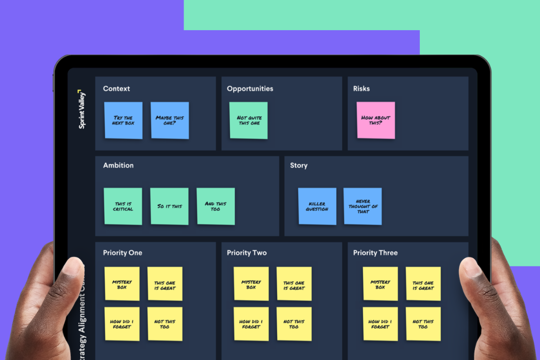
INSIGHTS BY SPRINT VALLEY
Ready to try the template?
Check out the Miro companion boards to use as a framework for facilitating your own session in-person or online.
What’s next for your strategic plan?
Congratulations on creating your one-page strategic plan! This high-level framework is not just a snapshot of your strategy; it’s the starting point for a deeper, more nuanced approach to planning. Now it’s time to consider how you’ll bring your high-level strategy to life.
Traditionally, many organisations have relied on a top-down approach: leadership creates the plan, outlines the actions, and expects teams to execute. While this method can be swift and decisive, it often struggles to build real momentum. The plan might be set in motion quickly, but progress stalls when the rest of the organisation isn’t fully invested. Without early input from key teams, this approach tends to lack ownership, resulting in disengagement, misalignment, and even resistance—making implementation slower and less effective in the long run.
We believe there’s a better way: the Collaborative Strategy Approach. With Collaborative Strategy, you engage your team and stakeholders from the outset and design the next-level plan in a way that taps into diverse perspectives. This method takes a little more time upfront, but the long-term payoff is substantial—greater buy-in, faster adoption, and a plan that feels owned by everyone, not just the leadership team. It’s about inviting the people who will execute the strategy to design the strategy, ensuring they understand the "why" behind every decision.
This approach creates a living strategy that can evolve with input from across the organisation. It’s dynamic, adaptive, and built on shared ownership, which means your team is motivated to bring it to life from day one.
People are more behind delivering the solutions moving forward [when] they're the people who made the decisions, they know why they made the decisions and they stand by the decisions they made.
Tim Ray, Head of Product - Sovelia, Symetri
Ready to bring your strategy to life?
At Sprint Valley, we help organisations go beyond the traditional top-down model by facilitating a Collaborative Strategy Approach that gets everyone on board from the start.
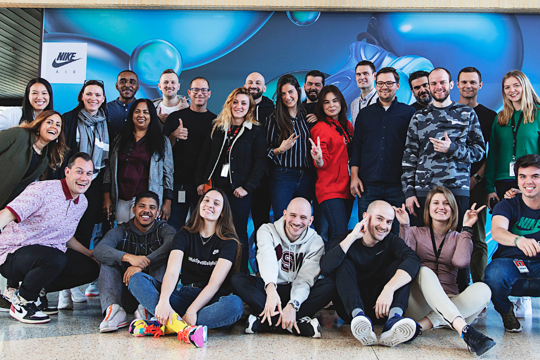
STRATEGY BY SPRINT VALLEY
Strategy stuck?
Move as one with a strategic plan your team design (and hold each other accountable to deliver).